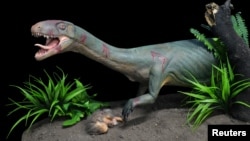Scientists have identified the oldest-known forerunner of the dinosaurs and are expressing surprise at how little it actually resembled one.
Researchers on Wednesday described fossils of a long-necked, four-legged, meat-eating reptile called Teleocrater rhadinus that reached up to 10 feet (3 meters) long and prowled a Tanzanian floodplain roughly 245 million years ago.
It lived during the Triassic Period millions of years before the first dinosaurs. Scientists called it a close cousin rather than a direct dinosaur ancestor.
Its appearance differed from what scientists had expected from the earliest representatives of the dinosaur evolutionary lineage. Teleocrater possessed an unexpected combination of crocodile-like and dinosaur-like characteristics.
"I'm surprised by the mosaic of features that it possesses," said paleontologist Ken Angielczyk of the Field Museum in Chicago, one of the researchers in the study published in the journal Nature.
"In terms of how it shakes up our understanding of dinosaur evolution, Teleocrater shows that the earliest members of the dinosaur lineage were very unlike dinosaurs, and that many 'typical' features of dinosaurs accumulated in a step-wise fashion instead of all evolving at close to the same time."
Dinosaurs belong to a larger group called archosaurs that about 250 million years ago cleaved into two branches: crocodilians in one and another that includes dinosaurs, extinct flying reptiles called pterosaurs, and birds, which evolved from feathered dinosaurs.
Teleocrater is the oldest-known member of the dinosaur-pterosaur-bird archosaur branch.
Scientists had expected such a dinosaur forerunner to be a smallish, two-legged predator resembling early dinosaurs such as Herrerasaurus, which lived about 231 million years ago in Argentina. While dinosaur predators were bipedal, Teleocrater instead was four-legged, looking superficially like a modern Komodo dragon.
Virginia Tech paleontologist Sterling Nesbitt, the study's lead author, said fossils representing at least four individuals were found in southern Tanzania, representing about half the skeleton.
Much like a croc and unlike a dinosaur, Teleocrater's ankle joints could rotate from side to side as well as flexing up and down, providing a crocodile-like gait.
It also boasted telltale dinosaur features such as characteristic depressions for jaw muscle attachment on the roof of the skull, extra surfaces for the backbones to attach to one another, and distinctive hip muscle attachments on the thigh bone.
Teleocrater's remains were found in the same Tanzanian region as fossils of the two-legged meat-eater Nyasasaurus, which lived perhaps a couple of million years later. Some scientists regard Nyasasaurus as the earliest-known dinosaur.





